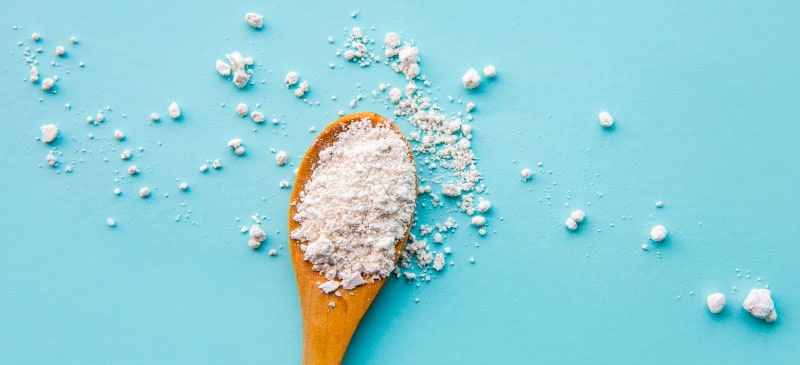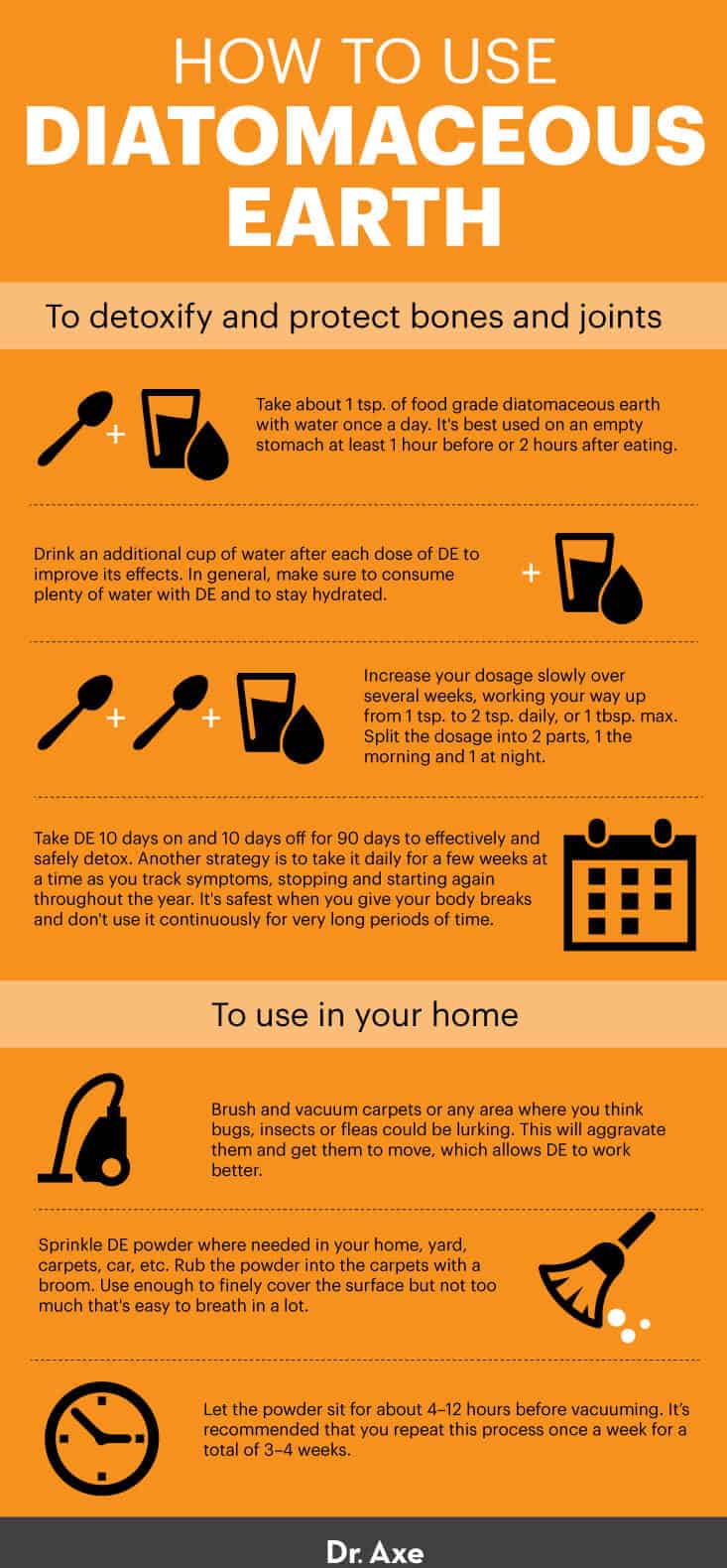
You may never have heard of diatomaceous earth before, but chances are you’ve consumed or used plenty of products that contain it. What is diatomaceous earth, and does it really work?
Diatomaceous earth is a powder that comes from the cell walls or shells of diatoms, or aquatic organisms. It’s commonly used by humans to promote detoxification, aid digestion, and improve skin and hair health.
For example, diatomaceous earth for fleas is extremely effective for your pets — but diatomaceous earth has many uses beyond that, with an astounding ability to kill pests and harmful substances in your home and purify liquids.
If you haven’t used this organic substance in your diet, home or garden yet, you’ll want to learn about its many benefits.
What Is Diatomaceous Earth?
Diatomaceous earth is a natural product made up of fossilized remains of tiny, aquatic organisms called diatoms. Composed of the cell walls/shells of single cell diatoms, it easily crumbles to a fine powder.
In fact, the composition of the diatom cell walls are biogenic silica. The substances used to make diatomaceous earth are safe and taken directly from the sea, since diatom silica deposits accumulate over time in the sediment of rivers, streams, lakes and oceans.
Silica used to make diatomaceous earth is a key common component of the earth’s rock, sands and clays. Silica is an important component of human ligaments, cartilage and musculature and is also abundant in plants since it facilitates their growth and development.
Studies demonstrate that it’s a healthy essential mineral for the body to build strong bones, hair, nails and teeth, and it’s needed to carry calcium into various parts of the body.
Research published in the Journal of Nutrition, Health and Aging shows that many forms of silica exist in nature, and compelling data supports myriad beneficial effects of consuming more silica. Orthosilicic acid is the form of silicon predominantly absorbed by humans and found in numerous tissues, including nails, bones, tendons, the aorta, the liver and the kidneys.
Compelling evidence exists that suggests silica is essential for health and has a strong anti-aging effect. Deficiencies in silica can contribute to:
- abnormal growth
- deformities in skull and peripheral bones
- joint pain caused from poorly formed joints and reduced contents of cartilage and collagen
- disruption of mineral balance
- damage to the femur and vertebrae
Types of Diatomaceous Earth
What are some products that contain diatomaceous earth? Diatomaceous earth is available in two different grades:
- Food-Grade — meant to be taken internally by humans
- Non-Food-Grade — used in industrial practices
Some common products that contain diatomaceous earth include dusts, powders (or a “powder duster”) and pressurized liquids that are used on the outside of buildings, on farms, in gardens, and in human and pet foods.
It usually comes in the form of a white powder and is also used in water filtering, food manufacturing, skin products and farming to naturally eliminate free radicals, viruses, insects, parasites and other harmful organisms by binding to them and drying them out. It also has the ability to improve the body’s use of calcium, support bone mineralization, protect joints and fight effects of aging.
Diatomaceous earth comes in several forms:
- granulated diatomaceous earth, a raw material made from crushing silica that’s usually available as a powder and safe for human consumption (to be food-grade, it must contain less than 1 percent crystalline silica)
- milled or micronized diatomaceous earth, a very fine substance used in pesticides and insecticides
- calcined diatomaceous earth, a heat-treated and activated form used in liquid filtering and explosives
You can purchase food-grade diatomaceous earth in some health food stores or online. Diatomaceous earth for your garden or pest control is also available at many home improvement stores.
Benefits for the Body
1. Detoxifies the Body
Diatomaceous earth — also known as diatomite — works like a natural detoxifying agent within the body, killing parasites and viruses that can contribute to illnesses while also helping to clean the blood. It’s also inexpensive, simple to use and much safer than many store-bought detox products or plans.
Some of the benefits of using diatomaceous earth internally include:
- reducing odors
- helping curb gas
- cleansing the digestive tract
- boosting liver function
- absorbing harmful toxins within the blood
How does diatomaceous earth work to help with detoxification?
Silica works similarly to antioxidants found in high-antioxidant foods because it retains its traits as a stable particle even while continuously suspended in a liquid medium, allowing it to fight free radical damage. It’s broken down into a colloidal, which acts like a detoxifier for the blood since it carries an electrical charge that attaches to free radicals and other harmful toxins.
Silica particles can then neutralize the charge of free radicals and remove them from the body through sweat, urine and feces, which slows oxidative damage and has anti-aging effects.
A study published in the American Journal of Clinical Nutrition found that silica also helps eliminate heavy metals from the body, such as aluminum, making it perfect for a heavy metal detox. In studies, it has been shown to have a high-aluminum affinity and reduces aluminum availability from the human gastrointestinal tract.
2. Fights Parasites
A 2011 study published in the Oxford Journal of Poultry Science suggests that diatomaceous earth has the potential to be an effective treatment to help control internal worms (parasites). Interestingly enough, this was observed in hens that produce organically raised, free-range eggs.
Giving two breeds of commercial egg-laying hens diatomaceous earth improved production of their eggs and egg quality compared to control groups, effectively working as a parasite cleanse in the process.
The two groups of hens used in the study were found to differ in their resistance to internal parasitic infections, which was observed by examining their gastrointestinal tracts. The hens fed diatomaceous earth had significantly lower incidences of infections.
Those fed diatomaceous earth were also significantly heavier in weight, laid more eggs and consumed more feed than hens fed the control diet — plus their eggs had larger yolks and therefore were more concentrated with nutrients.
3. Improves Joint, Bones and Ligaments Health
A 2007 study published in the Journal of Nutrition Health and Aging stated that dietary silicon is beneficial to bone and connective tissue and helps prevent low bone mass (osteoporosis), which is considered “a silent epidemic of the 21st century.”
Silica within diatomaceous earth helps with normal bone metabolism and joint formation, with evidence over the past 30 years suggesting there’s a positive association between dietary silicon intake and better bone mineral density. Thus, diatomaceous earth makes a healthy addition to any osteoporosis diet and treatment plan.
A number of possible mechanisms for how this works have been suggested, including the possibility that silicon helps with synthesis of collagen (used to form joints, the lining of the digestive tract and connective tissue) and within the mineralization of bones. While more research is still needed, it appears that silica supplementation can be used to help support normal metabolic processes, preserve healthy joints and prevent bone disorders.
4. Helps Clean and Protect Skin, Nails and Teeth
Since it has natural abrasive qualities and kills parasites, diatomaceous earth is used in many toothpastes, skin exfoliators, polishes and skin scrubs. Research suggests that just like other beneficial clays — like bentonite clay benefits and uses — diatomaceous earth dries out harmful toxins and leaves behind clean, smoothed skin with little to no side effects.
READ RELATED: Top 10 Vitamin B6 Foods
It also seems to have anti-aging effects by helping with the use of calcium in forming strong bones, nails and teeth.
Benefits for the Home
1. Helps Purify Water
Diatomaceous earth is used in many filtration products, including the trademarked brand name Celite, because its chemical composition makes it a great filtration aid. It’s able to filter very fine particles that otherwise pass through or clog filter papers.
This makes it a common product used in filters to help prevent tap water toxicity and also purification practices for fish tanks. Additionally, it’s also important for manufacturing beer, wine, syrups, sugar and honey without removing or altering their color, taste or nutritional properties.
A study published in the Journal of Applied and Environmental Microbiology found that diatomaceous earth helps kill viruses and purify liquids. Viruses have been found to be dangerous and abundant in certain sources of drinking water, raising the risk for viral infections and having a significant impact on bacteria and algae populations in the ecosystem.
Researchers tested the effects of a filter containing diatomaceous earth on tap water that was contaminated with heavy metals and various viral strains. The results of the study showed that diatomaceous earth helped absorb up to 80 percent of the viruses present, which were all present in the liquid, even after filtration.
2. Kills Insects and Other Harmful Substances in Your Home
In the U.S., diatomaceous earth is classified under the Federal Insecticide, Fungicide, and Rodenticide Act as a safe substance for household use. How does diatomaceous earth work to get rid of insects and pests?
It’s a natural insecticide, since it absorbs lipids from the waxy outer layer of insects’ exoskeletons, which causes them to dehydrate and die of water deficiency. This is why it’s also useful in food preservation, as a natural home deodorizer and cleanser, and for helping to treat livestock suffering from parasites.
Does diatomaceous earth kill fleas and ants? Research suggests that using diatomaceous earth can help eliminate bed bugs, house dust mites, cockroaches, ants (such as ant hills), fleas and other pests within your home without the use for harsh chemicals.
The website for Pest Control Technology indicates that silica gels have been used by the pest control industry for more than a half century since they safely produce an electrostatic charge that helps them adhere to critters crawling over treated surfaces.
Silica gel and diatomaceous earth have been found in studies to kill pests by removing a portion of the razor-thin, waxy outer coating that helps an insect conserve moisture. This allows them to work better than other products that rely on abrasion or poisoning.
Related: What Is Silicon Dioxide and Is It Safe?
How to Use
You may have wondered, “Is diatomaceous earth toxic or healthy for humans?”
Diatomaceous earth is safe for humans and animals to consume, and it’s also beneficial for skin — so it’s used both inside and outside the body. Just be sure to check the source, and make sure your product is food-grade. Skip using internally if it is not.
The U.S. Food and Drug Administration lists food-grade diatomaceous earth as “Generally Recognized as Safe,” which means that it’s legally allowed to be added to many different types of foods, beverages and supplements. Small amounts of silica are normally present in all body tissues and usually found in urine, too, so it’s well-tolerated and not known to cause many side effects.
Today there are over 150 pesticide-related products registered for use both indoors and outdoors that contain diatomaceous earth. There are also thousands of non-pesticide, food-grade diatomaceous earth products that are used on the skin, in food, in products for pets, and in supplements or medications.
There are a number of ways to use diatomaceous earth. Some of the most popular diatomaceous earth uses include:
- pet nutrition products
- products used on pets like dogs and cats to kill fleas
- bed bug-killing treatments
- sprays and products used for pest control, including cockroaches, crickets, fleas, ticks, spiders
- rodent sprays
- water filters
- skin care products
- toothpastes
- foods and beverages, such as in beer and wine
- anti-caking and clarifying ingredients used in food manufacturing
- supplements and medicines
- rubbers and paints used in construction
- abrasive products used as defoliators and for cleaning
Here are the recommended tips to subscribe to for safe use of diatomaceous earth as a detoxification agent and to protect bones and joints (but always consult with your health care provider before starting a new supplement routine):
- Take about one teaspoon of food-grade diatomaceous earth with liquid once a day. It’s best used on an empty stomach at least one hour before or two hours after eating.
- Drink an additional cup after each dose of diatomaceous earth to improve its effects. In general, make sure to consume plenty of water with diatomaceous earth and stay hydrated.
- Increase your dosage slowly over several weeks, working your way up from one teaspoon to two teaspoons daily, or one tablespoon max. Split the dosage into two parts taken in the morning and one at night.
- Take diatomaceous earth 10 days on and 10 days off for 90 days to effectively and safely detox. Another strategy is to take it daily for a few weeks at a time as you track symptoms, stopping and starting again throughout the year. It’s safest when you give your body breaks and don’t use it continuously for very long periods of time.
- As a note of caution, initially you might notice some mild side effects that can develop as your gut environment changes, yeast dies off and your body releases stored toxins. This can include mild headaches, fatigue and flu-like symptoms, which should diminish within a couple weeks.
Wondering what diatomaceous earth tastes like? If you eat diatomaceous earth, you’ll find that it’s basically tasteless and has a rough, gritty texture.
You can take it with liquid, even enhancing the taste with juice, yogurt or a smoothie if you prefer. It won’t dissolve when mixed into liquid, so it’s normal to see some residue. You can stir vigorously before consumption to break it up, but it’s still going to leave behind some chalkiness and a gritty texture, which is why disguising it is a a good tip.
Here’s how to use diatomaceous earth in your home:
- Brush and vacuum carpets or any area where you think bugs, insects or fleas could be lurking. This will improve the efficacy of diatomaceous earth for fleas and other pest problems because it aggravates them and gets them to move, which allows diatomaceous earth to work better.
- Apply diatomaceous earth powder where needed in your home, yard, carpets, car, etc. Rub the powder into the carpets with a broom. Use enough to finely cover the surface but not too much that it’s easy to breathe in a lot.
- Let the powder sit for about four to 12 hours before vacuuming. It’s recommended that you repeat this process once a week for a total of three to four weeks. This process can be done every few years or as needed.

Risks and Side Effects
Is diatomaceous earth safe? Although it’s generally recognized as safe to use on the body or to consume, some people react to diatomaceous earth by experiencing irritation and other side effects.
It’s possible for diatomaceous earth to irritate the nose and nasal passages when you breathe it in. If consumed in large amounts, it can contribute to coughs and shortness of breath.
It also has the potential to irritate the skin and cause some mild irritation and dryness. If you have sensitive skin, eyes or nasal passages, it’s a good idea to monitor your symptoms and watch out for any strong reactions.
It’s also recommended that you keep diatomaceous earth away from babies and small children who might be more sensitive to diatomaceous earth’s effects and can react to it by experiencing irritations.
As far as long-term exposure goes, in animal studies generally no health effects have been observed even after applying diatomaceous earth to animals’ skin five times per week for several weeks. In a rat study, researchers fed rats high doses of diatomaceous earth for six months and found no evidence of reproductive or developmental effects.
That said, there’s some evidence suggesting that inhaling a very small amount of crystalline silicon over time (the kind used in small quantities in some diatomaceous earth products, especially pesticides) might contribute to silicosis, chronic bronchitis, and other lung and respiratory problems in a small percentage of cases. However, the risk seems low considering the vast majority of diatomaceous earth used in products for human consumption is amorphous, not crystalline.
Impact on the Environment
Wondering if garden-safe diatomaceous earth can harm animals or contribute to environmental pollution? Evidence shows this is very unlikely and that diatomaceous earth is actually nontoxic to mammals, fish and aquatic invertebrates.
It’s commonly encountered by birds and other wildlife in nature but has been found to be harmless to birds, fish and other wildlife in numerous studies.
In fact, silica is naturally plentiful in the ocean, and seawater contains vast amounts of diatomaceous earth. The skeletons of many types of sea life and marine organisms are actually made using silica, and therefore it seems to pose no major risks to most species.
As far as plants go, diatomaceous earth can actually be beneficial since it’s used as a growing medium in potted plants. It’s sold as a soil additive and helps soil retain water and nutrients, while allowing for more oxygen circulation and killing off parasites.
It also helps preserve foods naturally (such as grains or legumes, which can grow mold) and helps replenish soil so more plants and food can be grown for livestock and human consumption.
Final Thoughts
- Diatomaceous earth is an organic product made up of fossilized remains of tiny, aquatic organisms called diatoms.
- Diatomaceous earth benefits include detoxifying the body; purifying liquids; parasite control; killing insects and other harmful substances in your home; improving joint, bone and ligament health; and cleaning and protecting skin, nails and teeth.
- Diatomaceous earth has been used for years as a safer pesticide option. Today, there are over 150 pesticide-related products registered for use both indoors and outdoors that contain DE.
- Diatomaceous earth is available in two different grades: food-grade (meant to taken internally by humans) and non-food-grade (used in industrial practices).
- Granulated diatomaceous earth, milled or micronized diatomaceous earth, and calcined diatomaceous earth are all available.
!function(f,b,e,v,n,t,s)
{if(f.fbq)return;n=f.fbq=function(){n.callMethod?
n.callMethod.apply(n,arguments):n.queue.push(arguments)};
if(!f._fbq)f._fbq=n;n.push=n;n.loaded=!0;n.version=’2.0′;
n.queue=[];t=b.createElement(e);t.async=!0;
t.src=v;s=b.getElementsByTagName(e)[0];
s.parentNode.insertBefore(t,s)}(window, document,’script’,
‘
fbq(‘init’, ‘3475171552810057’);
fbq(‘track’, ‘PageView’);



